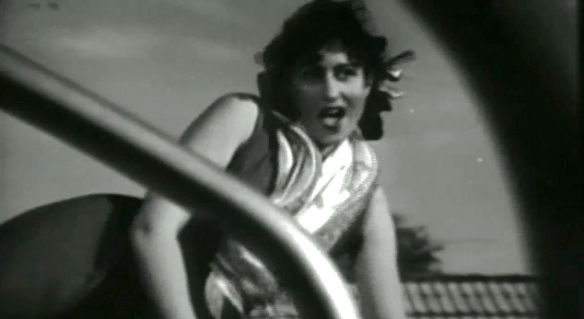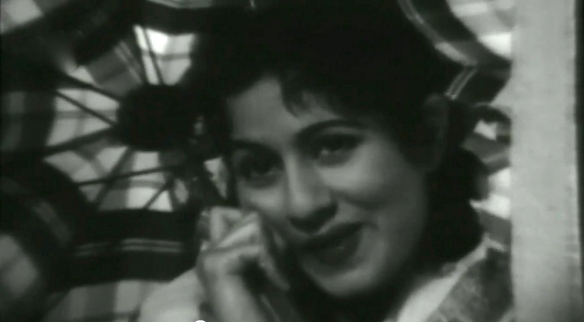Today we present the lyrics and English translation of “Thandi Hawa Kali Gata” from our very own namesake Mr. and Mrs. ’55 (1955). The film follows an unlikely young couple, Madhubala and Guru Dutt, who are forced together by circumstance and end up challenging their own social mores, maturing, and finding love to essentially become an ideal match—a figurative “couple of the year.”
People tend to have strong feelings one way or another for this film. The music is hands-down fantastic, but the plot tends to be divisive, depending on how you view Guru Dutt’s stance on female emancipation in the 1950s. I tend to argue that the film is empowering—his narrative is social criticism of the flaws in patriarchal society, as well as an exploration of non-traditional female roles. While Madhubala’s character does indeed discover many virtues of a conventional Indian housewife, her realization that she would prefer marriage to divorce comes with a refreshing sense of maturity and self-discovery that in no way shackles her independence. Unlike many great heroines of the era, in Mr. and Mrs. ’55, Madhubala is feisty and does exactly what she wants, when she wants! I like that about a woman.
Now let’s take this moment to talk about the ridiculous ribbons and pigtails flying around the set in this song. Don’t be shy, you know precisely what I’m talking about. Mr. and Mrs. 55‘ was not the first film (and certainly not the last) to idealize fully-grown women who did their hair like 5-year old girls. Every actress of Bollywood’s yesteryear from class-act Meena Kumari to joke-a-minute Asha Parekh has played the romantic lead with a hairdo that awkwardly imitates the elementary school kids. Yes, chew on that for a moment. There’s an entire slightly uncomfortable social theory behind the craze. Contrast this lunchbox look to Madhubala’s long flowing locks in the sweet duet “Udhar Tum Haseen Ho” toward the end of the film as she begins to accept her marriage to Guru Dutt. Symbolic, no?
But enough about my beef with pigtails. Sung by Guru Dutt’s own wife Geeta Dutt, there’s plenty to love in this uplifting jingle! Follow along with the video here and enjoy our English translation and lyrics to “Thandi Hawa Kali Ghata” below!
Thandi Hawa Kali Ghata Lyrics and Translation:
ThanDii hawaa, kaalii ghaTaa, aa hii gayii jhoom ke
A cold wind and black clouds have come with ebullience
Pyaar liiye, Dole, ha.Nsii, naache jiiyaa ghoom ke
Carrying love, laughter swayed, and my heart danced in swirls
baiThii thii chhup-chhaap yuu.N hii, dil kii kalii chhum ke mai.N
I was sitting quietly, caressing the flower of my heart
dil ne yeh kyaa baat kahii, rah na sakii sun ke mai.N
What my heart said, I could not stay there to listen
mai.N jo chalii dil ne kahaa aur zaraa jhoom ke
As I left, my heart spoke with even more exuberance
Pyaar liiye, Dole, ha.Nsii, naache jiiyaa ghoom ke
Carrying love, laughter swayed, and my heart danced in swirls
Aaj to mai.N apnii chhabii dekh ke sharam aa gayii
Today I became shy upon seeing my own reflection
Jaane yeh kyaa soch rahii thii ki ha.Nsii aa gayii
I do not know what I was thinking, but I suddenly laughed
LauT gayii zulf mere honTh meraa chhuum ke
My hair flew back and touched my lips
Pyaar liiye, Dole ha.Nsii, naache jiiyaa ghoom ke
Carrying love, laughter swayed, and my heart danced in swirls
dil kaa haar iktaar hilaa, chhiDne lagii raginii
The necklace of my heart struck a chord on the iktaar, and it began teasing out a melody
kajraa bhare nain liye, ban ke chaluu.N kaaminii
With kajra-lined eyes, I became a beautiful woman and set out
Keh do koii aaj ghaTaa barse zaraa dhoom se
Someone tell the clouds to rain thunderously today
Pyaar liiye, Dole, ha.Nsii, naache jiiyaa ghoom ke
Carrying love, laughter swayed, and my heart danced in swirls
ThanDii hawaa, kaalii ghaTaa, aa hii gayii jhoom ke
A cold wind and black clouds have come with ebullience
Pyaar liiye, Dole, ha.Nsii, naache jiiyaa ghoom ke
Carrying love, laughter swayed, and my heart danced in swirls
Glossary:
ThanDii: cold, hawaa: wind; kaalii: dark; ghaTaa: cloud; jhoom: ebullience, exuberance; Dolna: to sway; ha.Nsii: laughter; naachnaa: to dance; jiiyaa: soul, heart; laughter; ghoomnaa: to swirl; chhup-chhaap: absolutely quietly; chhabii: reflection, image; sharam aanaa: to become embarrassed, to become shy; zulf: hair; honTh: lips; haar: necklace; iktaar: a traditional Hindustani one-stringed instrument, raginii: a small song, kajraa: traditional Indian eyeliner; nain; eyes; kaaminii: a beautiful, desirable woman; koii: someone; barasnaa: to rain; dhoom se: with noise

Madhubala and her girlfriends join hands in a chorus of pigtails and parasols in Mr. and Mrs. ’55 (1955).
Don’t you love how this film is just bursting with the tension of modernization? Like many typical “coming-of-age” songs, lyricist Majrooh Sultanpuri employs nature-based allegories to describe a girl’s maturation to womanhood and the development of romantic inclinations. However, the song is unexpectedly filmed at the uber urban hangout of Mahatma Gandhi swimming pool in Bombay’s Shivaji Park! Gotta love those modern girls. Producer-director Nasreen Munni Kabir describes Guru Dutt’s cinematographic decision-making process while filming this song in her must-see documentary “In Search of Guru Dutt“!
This brilliant Geeta Dutt hit was requested by loyal fan Sonia! We know we’ve been taking longer than usual to get around to requests, but with Mr. 55 getting swamped in medical school and me getting down to the wire for wedding planning, we’re doing our best! Stay tuned–we love hearing from our fans!
– Mrs. 55



Wonderful song and Madhubala looks, as usual, divine in this black & white song. Wish Aalia Bhat or Parineeti Chopra of the current generation lip-sync and dance to this song in one of the many award shows!
Every now and then, these award shows revive a an old classic! We’ll be keeping or fingers crossed for this one too!
Mrs. 55:
You are amazing. Thanks so very much for your efforts. I love Hindi and Urdu Bollywood songs.
I have lived 34 years in the US but spent the first 22 years of my life in Bombay as did my wife. We have a 17 year old daughter and she has trouble distinguishing Hindi from Marathi…. I guess it is our fault since we only spoke English at home.
If you spent your formative years in the US, I am amazed that you have so much knowledge of and love for old Hindi songs.
Keep up the good work,
Parag Gupte, Houston, TX
Sent from my iPad
>
Thank you Parag! We are so touched that you enjoyed our blog. Learning Hindi and Urdu as a second-generation immigrant is always a challenge. Mr. 55 and I can both relate to your daughter’s experience as neither of our parents spoke the language routinely at home. But we’ve always held that classic Hindi films are the BEST way to learn! Perhaps it’s time for a weekly Guru Dutt move night? 😉
Greetings, Mrs. 55.
I stumbled upon your delightful and informative blog while seeking a good English translation of “Pritam aan milo” and trying to understand the origins of the movie title “Mr. & Mrs. 55.
So I have this anticlimactic moment, Mrs. 555, like “Kunta Kinte, I’ve found you!” or Archimedes’ “Eureka!” but tempered by the fact that there’s still nether explanation for the “55” nor a good translation of the song.
Please elucidate.
Dhanyavaad, shukriya, mehr baani!
Hi Mani,
Thanks for your kind words on our blog! Glad you stumbled across us. While we don’t yet have the translation of “Preetam Aan Milo” on our site, perhaps I can help you with the second part of your search: the meaning of the title of the film Mr. and Mrs. ’55! As you know, the film centers on an unlikely couple who defies odds to fall in love and challenge the social mores of their era. Released in the year 1955, the film Mr. and Mrs. ’55 makes an semi-ironic reference with its title–the couple is hailed literally as the “couple of the year.” Today, the apostrophe before the 55 is often forgotten, further obscuring the true origin of the title. Yet this meaning is why we loved the name of the film so much and named our website after them. Trapped in the wrong era, Mr. 55 and I both wish we were a young couple from the year 1955!
Hope that helps 🙂
Mrs. 55
Thanks for the prompt reply and the clarification on ’55.
While I did think of the year the film was made as being the source of the title I thought that a tad too simple. It seemed too dehumanizing to use for a “Couple of the Year,” which might have been the better choice. Using the Indian Penal Code for cheating was appropriate for “Shree 420,” however, for it is appropriate to “keerdas” like them. 🙂
Glad to help! What I like about actually referencing the year the film was made is that it locks the social constraints the characters are fighting firmly into an exact moment in Indian history. The cultural context is glued to that era–would such characters have existed even 10 or 15 years later? Of course, the reason Mr. 55 and I love it the most is simply that we recognize something of ourselves in the reference 🙂
Isn’t it raagnii, not raaginii?
Also, I believe the singer is saying chun = having picked (flowers, etc), not cchun == having caressed.